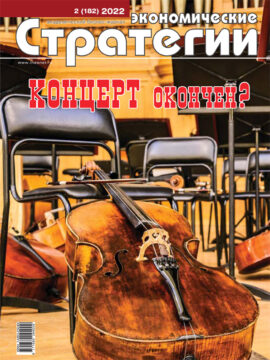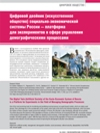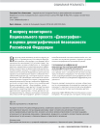The Digital Twin (Artificial Society) of the Socio-Economic System of Russia is a Platform for Experiments in the Field of Managing Demographic Processes
DOI: https://doi.org/10.33917/es-2.182.2022.6-19
One of the most promising tools for monitoring and predicting social processes are agent-based models, which are widely used abroad. Their advantage lies in the consideration of the system under study at the level of its individual individuals, which increases the realism of these computer-based assessment methods. In Russia, this direction is also developing, although not so actively. The article discusses the dynamics of the population of Russia, as well as the factors of increasing the birth rate, successful examples of the practical implementation of agent models for studying social processes, a brief description of the model we developed, which includes 146 million agents, is given. With the help of this tool, a forecast of the population of Russia and an assessment of the impact on this indicator of some measures aimed at improving the demographic situation were obtained.
Источники:
1. Makarov V.L., Bakhtizin A.R., Il’in N.I. Modelirovanie i otsenka natsional’noi sily Rossii [Modeling and Assessing the National Strength of Russia]. Ekonomicheskie strategii, 2020, no 2, pp. 6–19, available at: DOI: https://doi.org/10.33917/es-2.168.2020.6-19.
2. Makarov V.L., Bakhtizin A.R., Il’in N.I., Sushko E.D. Natsional’naya bezopasnost’ Rossii [National Security of Russia]. Ekonomicheskie strategii, 2020, no 5, pp. 6–23, available at: DOI: https://doi.org/10.33917/es-5.171.2020.6-23.
3. Andreev E.M., Darskii L.E., Khar’kova T.L. Naselenie Sovetskogo Soyuza: 1922–1991 [Population of the Soviet Union: 1922–1991]. Moscow, Nauka, 1993, 143 p.
4. Federal’naya sluzhba gosudarstvennoi statistiki [Federal State Statistics Service], available at: https://rosstat.gov.ru.
5. Zdravookhranenie [Healthcare]. Federal’naya sluzhba gosudarstvennoi statistiki, available at: https://rosstat.gov.ru/folder/13721.
6. Sobotka T., Matysiak A., Brzozowska Z. Policy responses to low fertility: How effective are they? Working Paper, May, 2019, N 1, available at: https://www.unfpa.org/sites/default/files/pub-pdf/Policy_responses_low_fertility_UNFPA_WP_Final_corrections_7Feb2020_CLEAN.pdf.
7. The World Bank, available at: https://data.worldbank.org.
8. Aganbegyan A.G. O katastroficheskom uvelichenii smertnosti i merakh po sberezheniyu naroda v Rossii [On Catastrophic Increase in Mortality and Measures to Save the People in Russia]. Ekonomicheskie strategii, 2021, no 4, pp. 6–13, available at: DOI: https://doi.org/10.33917/es-4.178.2021.6-13.
9. Country Comparisons — Death Rate. The World Factbook, available at: https://www.cia.gov/the-world-factbook/field/death-rate/country-comparison.
10. Goldstein J.R., Koulovatianos C., Li J., Schr der C. Evaluating how child allowances and daycare subsidies affect fertility. Goethe University Frankfurt am Main, available at: http://nbn-resolving.de/urn:nbn:de:hebis:30:3-430067.
11. Kalwij A. The impact of family policy expenditure on fertility in western Europe. Demography, 2010, N 47(2), pp. 503–519, available at: DOI: https://doi.org/10.1353/dem.0.0104.





